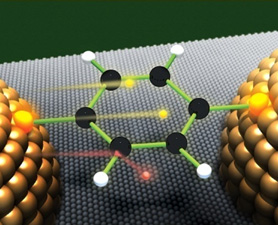Nobody can doubt scientists’ effort when it comes to transistors and their importance in modern technological advancements. Over time, transistors have been in the market, designed from singular molecules. Electron flow in these transistors has been facilitated by the modulation of energy produced by molecular orbits or orbital. This behavior has greatly influenced the genesis of current and future molecular transistors and other devices. Since transistors (integration of circuit elements) work with the electric current flowing within the electrodes (drain and source electrodes), trying to improve voltage put to the 3rd electrode, normally referred to as gate electrode, the manufacture of these transistors takes time, money and energy.
Determination by scientists and researchers so far have a fruit; they have made a breakthrough with the first molecular transistors being made. This transistor brand is made from one molecule, has its benzene molecule bonded to the vibrant gold contacts, and works or performs like the silicon transistors. The presence of varying energy degrees in the molecule can easily be manipulated by varying states of energy. Through this, you can be able to assert yourself in controlling the passage of current via it.
Initially, transistors that could easily switch on electrical signals in nature were designed to solve the problems caused by vacuum tubes. The vacuum tube was substantially big in size, and most could not be relied upon. Besides, they used so much power. The emergence of silicon transistors solved many of these issues and gave birth to an age of portable, compact, and now molecular electronic devices.
With the molecular transistors available, things could improve even further. More fantastic developments will open an era where very few atoms could perform difficult electron circulations, making it possible for many paralleled computers to be designed. Since the time Mark Reed identified that single molecules could be arrested between electronic contacts, most present researchers have been trying to develop an actual molecular transistor that truly works.
This new molecular transistor can be switched on by letting the scanning tunneling microscope tip near the molecule or simply getting the adaptor or acceptor molecule on to it through a concise molecule link. The first way allows the gate electrode that is very near to control de-coherence via molecule polarization. One importance of new molecular transistors is that they can effectively be used in aqueous locations such as living organisms’ interior; a promising breakthrough indeed worth the praise.
What has happened in these molecular transistors is the fabrication of electrical contacts on minimal scales, looking and selecting molecules to be put to use, fixing them, and their ultimate connection to contacts. For this reason, so many years have been eaten up just to come up with a small, functioning molecular transistor. Some researchers are ecstatic with this decade’s breakthroughs of the functional molecular transistor. They have shown that with the use of molecules in transistors, more is yet to come.


